
Atlas F1 Technical Writer
The Malaysian Grand Prix always presents a gruelling challenge for the Formula One teams and their drivers, with track temperatures reaching up to 50 degrees Celsius. This year's race was no different, and both cars and drivers were put to the test again. Atlas F1's technical writer Craig Scarborough reviews how the teams managed to cope with the conditions over the weekend
In addition, the teams had the extreme heat to deal with in Malaysia - both air temperature and track temperature were as high as they would get throughout the season - giving the cars, drivers and their tyres a hard time in coping. With track temperatures remaining high all weekend, Michelin ended up with the better mix of grip and durability, perpetuating the myth that Michelins work better in the heat.
Since the heat was expected, the teams had pre-planned and brought an arrangement of cooling aids for the cars. And while the teams weren't expected to run other alterations to the cars, some were able to bring new parts to this race either in the form of revised engine specification or aerodynamic aids for downforce.
Cool It
Hence, cooling improvement centres on the removal and exit of the heated air from the rear of the sidepods. To that end, the teams use chimneys and flip-ups. Increasing the size and number of these outlets improves cooling, but at the expense of drag and even downforce, should they interfere with air-flow to the wings behind them. Subsequently, the engine technicians want more outlet area for reliability and the chassis engineer wants less for speed. A compromise needs to take into account of the circuit layout, the downforce/drag ratio required, and the engine's needs on oil/water cooling.
Up to a point, oil temperature tends to be more important in reliability as it keeps the mechanical parts of the engine cool and lubricated. Water temperature tends to affect power first before causing reliability problems. Therefore, at races like the Malaysian Grand Prix, teams run a split or asymmetrical cooling layout - Renault, for one, ran this frequently last year. However this is not done primarily for aerodynamic benefit; when oil coolers are carried only in one sidepod, then that sidepod needs more outlet area.
Away from the engine bay, two additional sources create heat - both affecting the driver's comfort in the cockpit.
The power steering rack placed across the opening in the front of the chassis is hydraulically powered and generates a lot of heat, which flows back directly towards the driver in the enclosed foot well. Likewise, a large number of electronic boxes inside the cockpit generate heat, these boxes usually scattered around the spare area on each side of the base of the seat.
With the driver dressed in nomex underwear and multi-layer overalls, the heat around him can soon start to hinder his performance. And, when the ambient temperature is as high as it is in Malaysia, driver cooling becomes a major issue. The problem is, there is little that can be done to ease this heat without resorting to major changes to the chassis, which would in turn affect aerodynamic drag and crash worthiness.
Tyres
Sepang's track surface is not rough on tyres, but with the elevated track temperature tyres are given a workout as they try to retain their grip and wear qualities during a run. Track temperature was high all weekend, peaking at over 50 degrees and often in the mid thirties.
Tyres produce grip from their construction and compound. Construction is the lay-up of the belts, plies and rubber forming the tyre's carcass. This is the mechanical part of the tyre and provides the car with a degree of suspension movement and decides how the contact patch is shaped. Its design can be accurately modelled on computers and is less sensitive to heat. Although important, new constructions do not create large improvements in lap time - this is largely down to the compound.
Compounds are the chemical make up of the rubber, which actually contain no natural rubber at all. This is the black art of tyre manufacturing; the compound provides the grip, resistance to wear and degradation. Degradation is the loss in performance of the compound and is often more important than wear in deciding race tyre strategy. Degradation can be permanent or temporary, as a tyre can "go-off" for a few laps before gripping again.
Compounds are very sensitive to heat - generated from track temperature as well as the heat the driver puts into the tyre through corners, braking and acceleration. When overheated, the compound "goes-off". Aside from losing grip, this can lead to graining or blistering, which actually damages the compound and its bond with the tyre's carcass.
Sepang showed that Michelin's compounds worked better in the heat than Bridgestone's, providing less degradation even if they produces less grip overall. Bridgestone found their softer tyres were going-off before the end of the qualifying lap and suffering a drop off during a race stint. Fortunately the race drop-off lasted only a few laps, although after another period of grip the tyres went off completely at the end of the stint.
This problem affected Michael Schumacher, who wanted to opt for a one stop strategy after his earlier problems but found the tyres would not last the longer stints. The mid stint drop-off affected Rubens Barichello's chase of Kimi Raikkonen, and Jenson Button's tyres had completely gone off, losing him two places on the last lap.
Both Michelin's and Bridgestone's tyres were prone to different grip with different track temperatures - an issue that was highlighted primarily during both qualifying sessions, which saw varying temperature of up to 10 degrees. Since teams can no longer wait for the optimum track temperature before going for their fastest lap, they now have to perform at a set time whatever the track conditions and reinforces the FIA's aim to shake up the grid with this new qualifying.
Team by Team
McLaren
David Coulthard had a clean Friday morning session and ran first in Q1, having won in Australia. His car handled well and he posted a time for fifth to last in Q2. After a run off the road in Saturday's morning session, his Q2 lap was fast in sector 1 but he struggled in sector 2, and with a top speed of only 297km/h, he could not beat the light-running Michelin shod Renaults.
Kimi Raikkonen had problems in the morning on Friday and his Q1 lap was less balanced than Coulthard's but ultimately faster. In Q2 he was amongst the many to match the faster sector 1 time, but started to lose time and made an error in the tight turn 9.
Expecting to run in the race with lots of fuel on board, Coulthard's race was first upset by Schumacher pushing him wide in the first corner melee and then electronics failure stopping him out on the track on lap 3, leaving the Scot to comment angrily that reliability is "just not good enough."
Raikkonen avoided the worst of the first corner mess and with longer fuel stop on lap 20 than the later stop on lap 40 ran faultlessly to the finish.
Ferrari
Running the older and revised F2002, Ferrari had no major changes to the car. Cooling was improved with a larger cooling outlet in front of the flip-ups, as well as the cockpit's vents and drilled windshields.
As first retiree in Australia, Rubens Barrichello ran last in Q1 and with a cooler track, a fast speed trap figure of 304.8kmh and smooth driving, he was able to set the second fastest time. He was less controlled in the Q2 session, matching the fastest sector one time, losing a tenth in the second sector, before an error in turns 13 and14 lost him another four tenths in sector three.
In the race, Ferrari's two-stop strategy was disrupted by Schumacher hitting Renault's Jarno Trulli on the opening lap, losing both drivers time and forcing Schumacher in for a new nosecone and a later drive-through penalty.
At the first stop Michael was refuelled with the aim of switching to a one-stop race, but his tyres would not hold up for the long stints and he had to stop on laps 27 and 41. Barrichello, also delayed in the first lap incident, ran a two-stop strategy, coming in on laps 21 and 38, but struggled with his tyres' performance in the mid stint.
The Ferraris were among the fastest cars on the straight, with Schumacher clocking 307km/h, perhaps trading the downforce to preserve their tyres in an effort to allow overtaking.
Renault
Only a small cooling outlet placed along the lower edge of the sidepod was needed to provide extra cooling for the Renaults. Their running in the Friday session gave the team some insight on tyres and thereafter the French-owned team approached the weekend much more tactically than in Australia.
Technical director Mike Gascoyne makes the strategic calls on race weekend, and as both a team head and designer he delights in the unconventional. Last weekend proved the gamble Renault took with limited testing and an adventurous approach to race fuel was successful. This strategy has proven necessary, as the Renault is down on power and this is now more obvious as they are nearing the top three teams in terms of handling and lap times - only the car's straight-line speed suggests its lack of power. This is something Renault can now work on with the reliability found by adding counter-balancers to damp out the vibration on the wide-angle engine.
In Q1, both drivers put in tidy laps, with over a 10km/h deficit to the Ferraris. Moreover, Jarno Trulli and Fernando Alonso put in lap times within a few tenths of McLaren and Williams. Saturday found Alonso nursing a fever and running 11th on the road for Q2, but amazingly he put in a lap time quick enough to give him pole position. Obviously the Renault was running with less fuel on board than their rivals, But Alonso's car was planted to the road on an error free lap.
This was backed up by Trulli's lap four cars later, the Italian matching his teammate's time in sector 1, losing two tenths in sector 2 and regaining them with a higher top speed to finish the lap only 0.17 behind Alonso.
The race start saw the Renaults get a short lead before being caught by Coulthard and Schumacher by turn 1. Trulli was hit hard from behind by the World Champion, spinning him off the track and rejoining well down the field. Meanwhile, Alonso lead until his first and rather lengthy stop on only lap14, the Spaniard heavily refuelled for a long second stint, running twenty laps before making another stop. The second stop also included a front wig adjustment.
Later on Alonso had a gearbox problem, losing him fifth gear, and misfiring engine. Nonetheless, his car and his fever held together to allow him to finish third and on the podium for the first time.
Jarno Trulli meanwhile stopped on lap16 and almost stalled as he dropped the clutch too fiercely. His pit problems continued on lap 36, when his electronics found him in neutral, slowing him to a halt in the pitlane and closing his fuel filler. The team manually opened the flap and sent him out twenty seconds later. He rejoined to fight with Michael Schumacher and Button, but without the top speed to pass on the straight he had to wait for Buttons tyres to go away on the last lap.
Williams
With the car's deficiencies still unsolved, Patrick Head remained in the UK for the race weekend and promptly sacked two key design staff. Yet the Williams turned up as the most changed car on the grid, the simplistic conclusion that the FW25 does not have enough downforce was strengthened when the rear end was adorned with new flip ups and winglets.
Williams also changed their winglet on top of the sidepods - the cantilevered design pioneered by Ferrari last year - but the Italian team only used one aerofoil section, suggesting the single mounting plate was insufficient to withstand greater downforce with out flex. Williams have tacked on an extra section to form a two-element winglet and appear to have retained rigidity. This extra rear end downforce helps the car in advance of a new aerodynamic package rumoured for Brazil.
The new rear suspension that was tried briefly in Australia was not evident in Malaysia, as the team retained the older layout with coil springs. Williams already use large cooling chimneys around the exhausts; these were aided in Sepang by new outlets on the flanks of the sidepods above the flip ups.
Juan Pablo Montoya's weekend started with good lap in Q1, and he matched the McLarens for top speed at 303km/h. His Q2 lap was hindered by a lack of traction onto the main straight, dropping his top speed and lap time by several tenths.
Ralf Schumacher continued to struggle with the one-lap format, his Q1 time being both slower than Montoya's by almost a second and almost 6km/h slower on top speed. Q2 was much the same, the front tyres looking rough by the end of the lap, and again the German was slower in lap time and top speed over his teammate. Moreover, Schumacher's lap time could not be blamed on fuel load as he made a two-stop race, which eventually lead to fourth at the race's end.
Montoya's race was ruined when Jaguar's Antonio Pizzonia ran up the inside and hit the Williams, taking off Montoya's rear wing and forcing the Colombian to take a very long pitstop in order to change the assembly for a new one. He then ran a one stop race but had already lost three laps on the leader.
Sauber
Uniquely on the grid, Sauber did not require any extra cooling outlets to keep the Ferrari engine down to temperature. The Saubers also found the Bridgestones to work well, with Nick Heidfeld tipping the sector 1 times in the Q1, and both drivers beating a Renault and both BARs on the timesheets.
With more fuel on board and hotter weather during the second qualifying session, the Bridgestone tyres were now going off long before the end of the lap. Sector 1 still saw the cars on the pace, but Heidfeld in particular struggled increasingly with poor grip around his Q2 lap.
In the race the two-stop strategy was slowed by trouble with the clutch/gears that allow the drivers to exit the pit, and both drivers stalled on their first stops.
BAR
After troubles in Australia with radios and Honda engines, the team brought revised versions of both to Sepang. They also introduced yet another cooling outlet to the BAR005 in addition to the flip-up outlet seen in Melbourne. The exhaust pipe is now wrapped with a chimney similar to Ferrari's, but as with the extra flip-up outlet this was only run on the left hand side of the car, suggesting the oil coolers are placed this side.
In the second qualifying session Villeneuve was similarly error ridden with several lock-ups and some understeer. Button was not as neat as in Q1, but his tyres were also falling away.
Villeneuve's bad weekend carried over to the race when a gearbox fault prevented him from leaving the grid for the formation lap, and he had to run to the spare before being redirected back to the original race car - under the new regulations the drivers can no longer simply switch to the spare car without prior authorisation of the race stewards.
Button had troubles on his second pit stop, when he entered the pits too slowly due to an electrical problem. After that, the Briton found his tyres to be deteriorating increasingly, and his drinks bottle wouldn't work. The chronic oversteer forced him to cede two places on the final lap.
Toyota
First qualifying saw Olivier Panis's car jumpy over bumps. Christiano da Matta's lap was marred by a lock-up in the last corner, but he was still faster than his teammate. Panis's car was still jumpy in Q2, and da Matta had to use the spare car after clutch problems forced him out of his race car. In both sessions the Toyotas were among the fastest down the final straight.
Panis planned a two-stop race strategy but immediately after is first stop he pulled off the track with gearbox failure. Da Matta was on a one-stop race, coming in on lap 32 and finishing eleventh, one lap behind the leader.
Jordan
All weekend the cars lacked grip, Giancarlo Fisichella was openly critical of the car and team, but his experience in set-up allowed him to find a better balance for the grip available, and this set up was passed to the less experienced Ralph Firman.
The drop off with the Bridgestone tyres made the problem worse in the qualifying runs. Fisichella's Q1 run was neat but Firman continued to bully the car around his lap, with rough inputs to the steering wheel and accelerator.
In Q2, Firman improved his technique and although the car displayed a lack grip with power oversteer increasing towards the end of the lap as the tyres dropped-off, his lap was much better. Fisichella managed to find grip and balance in the car even with the tyre problems. However, it was at the start of the race that Fisichella's experience let him down, as he turned into his grid slot too late and was parked at an angle to the track. Subsequently his launch control failed and he was left on the grid and forced to retire without as much as running a single lap.
Minardi
New detail appeared on the Minardi - long cooling chimneys replaced the upper air of flip-ups for cooling and the rear wing featured a small lift in the centre section in a more subtle manner to the delta wings seen at BAR and McLaren.
In development for over a year by Minardi and their German partner is a new power steering system. The system is designed to use less hydraulic power and hence sap less engine power. This was only available for Verstappen and the opening in the nose cone for Verstappen's car cooled him from the heat coming off the unit. Justin Wilson retained the heavier manual steering.
Both drivers struggled to post fast lap times in the qualifying sessions, and despite tidy runs and running low wing levels to bring up top speed, the cars set the slowest times in Q1.
In the race, Verstappen was taken out by Pizzonia at turn 1. He pitted for a new wing but lost 4 laps by the race's end to winner Raikkonen. Wilson suffered a lost wheel caused by a faulty retention mechanism on Saturday morning losing him track time to acclimatise to his first visit to the circuit. His race was going well, when he had to pull in on lap 46 to retire as the lack of power steering and his HANS collar had trapped a nerve in his shoulder.
Jaguar
Problems at Jaguar on basic engineering level persisted at Malaysia. Mark Webber has become critical of the car, saying it's overly conservative. If that wasn't enough, the team found the fuel pump would not pick up the last 20kgs of fuel from the tank, which meant the team ran a 20kg penalty all weekend and limited fuel capacity for long stints in the race.
These problems first arose when Antonia Pizzonia tried to the leave the pits for his Q1 lap and the engine wouldn't start, preventing him from taking to the track in the allotted time. Webber got out for his lap and posted a respectable time. In the second qualifying, Pizzonia drove a more controlled lap than in Australia but did suffer some snap oversteer when he was over enthusiastic with the throttle. Webber's lap was also tidy, but he was hindered by the almost full fuel tank.
At the start of the race, Pizzonia's over enthusiasm caused the second part of the first corner pile-up, running up the inside he hit Montoya before veering off into Minardi's Jos Verstappen, taking off both their rear wings and his own front wing. On lap15 Webber came into the pits unexpectedly early and stalled as he tried to exit after fuel and tyres were fitted. Stuck in gear, he was bump started out of the pit. Just over twenty laps later he drove into the pits to retire with an engine failure.
The Malaysian Grand Prix was expected to provide a clearer picture of the teams' competitiveness, but the race at Sepang International circuit was the second event with incident- filled opening laps and the threat of rain. Round two did however bring the first evidence of mixed-up grids, as teams split race fuel strategy, pushing otherwise slower cars to the front of the grid.
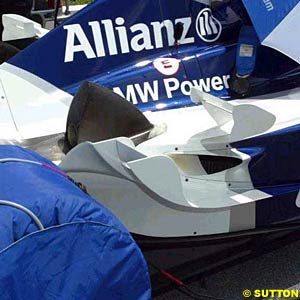 Keeping all the parts of an F1 car cool is a full time task for the designers. The engine requires most cooling - creating nearly 900bhp from such a small unit creates masses of heat. Most of this heat is absorbed by the water and oil circulating inside the engine; this is carried to the radiators placed on both side of the chassis and cooled by the air passing through the sidepods. Getting air into the sidepods is not a major problem - some teams may run smaller bargeboards to assist this - but the inlet area is generally a fixed size per car.
Keeping all the parts of an F1 car cool is a full time task for the designers. The engine requires most cooling - creating nearly 900bhp from such a small unit creates masses of heat. Most of this heat is absorbed by the water and oil circulating inside the engine; this is carried to the radiators placed on both side of the chassis and cooled by the air passing through the sidepods. Getting air into the sidepods is not a major problem - some teams may run smaller bargeboards to assist this - but the inlet area is generally a fixed size per car.
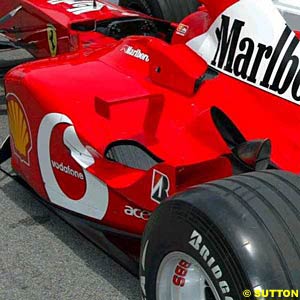 The engine also radiates heat, particularly as the exhausts are in close proximity to the bodywork and suspension. Therefore, virtually every surface inside the rear of the car is covered in heat reflective material - either in the form of gold film, alumised cloth or textured metal panels - in an effort to reflect the heat and retain the reliability of the component inside. The gearbox also produces a lot of heat, which requires a small oil cooler to be placed behind the engines airbox and be fed by a duct from the airbox itself.
The engine also radiates heat, particularly as the exhausts are in close proximity to the bodywork and suspension. Therefore, virtually every surface inside the rear of the car is covered in heat reflective material - either in the form of gold film, alumised cloth or textured metal panels - in an effort to reflect the heat and retain the reliability of the component inside. The gearbox also produces a lot of heat, which requires a small oil cooler to be placed behind the engines airbox and be fed by a duct from the airbox itself.
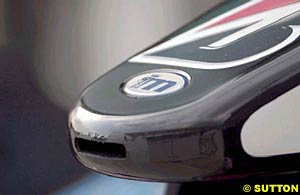 Nevertheless, most teams running power steering add a small vent in the tip of the nose cone; other team are also able to mould small ducts into the access panels on the top of the chassis - Ferrari and BAR, for example, often use these. Moreover, in last weekend's race, drivers were seen with the collar undone on their overall to allow for ventilation, and wore helmets with a variety of cooling vents set into mouldings on the crown and chin bar.
Nevertheless, most teams running power steering add a small vent in the tip of the nose cone; other team are also able to mould small ducts into the access panels on the top of the chassis - Ferrari and BAR, for example, often use these. Moreover, in last weekend's race, drivers were seen with the collar undone on their overall to allow for ventilation, and wore helmets with a variety of cooling vents set into mouldings on the crown and chin bar.
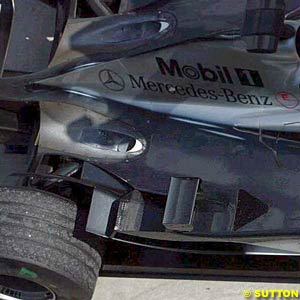 With the confidence that the older MP4/17D can still win races, McLaren ran an unrevised car at Sepang. Cooling was aided by the smaller and simpler bargeboard package along with small triangular vents cut into the sidepods ahead of the winglets, identical to those run last year. The team have been tight lipped about the clutch paddle-less gearbox system, which is rumoured to have an alternative to the conventional multi-plate carbon-carbon clutch.
With the confidence that the older MP4/17D can still win races, McLaren ran an unrevised car at Sepang. Cooling was aided by the smaller and simpler bargeboard package along with small triangular vents cut into the sidepods ahead of the winglets, identical to those run last year. The team have been tight lipped about the clutch paddle-less gearbox system, which is rumoured to have an alternative to the conventional multi-plate carbon-carbon clutch.
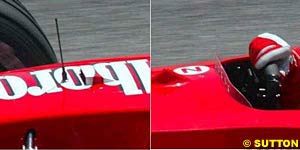 Having struggled in the Friday morning session, Michael Schumacher was fourth out in the first qualifying session (Q1) and immediately set what was to be the fastest lap. Come the Saturday morning session Michael again struggled, running off the track and damaging his underfloor. This was changed along with the gearbox - as a fault was detected - in time for the second qualifying session (Q2). Running last, Schumacher matched the fastest times in sectors 1 and 2, but he then suffered increasing oversteer from his tyres to lose nearly a third of a second in the 3rd sector.
Having struggled in the Friday morning session, Michael Schumacher was fourth out in the first qualifying session (Q1) and immediately set what was to be the fastest lap. Come the Saturday morning session Michael again struggled, running off the track and damaging his underfloor. This was changed along with the gearbox - as a fault was detected - in time for the second qualifying session (Q2). Running last, Schumacher matched the fastest times in sectors 1 and 2, but he then suffered increasing oversteer from his tyres to lose nearly a third of a second in the 3rd sector.
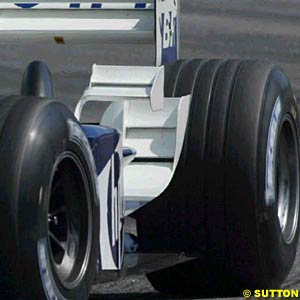 The Williams was launched with unique flip-ups - with an extra aerofoil section on their trailing edge. This has now been bolstered to two extra aerofoil sections, the steep curve of these flip ups could be prone to stall or separate. Adding the extra sections could relieve this problem and add downforce at the same time.
The Williams was launched with unique flip-ups - with an extra aerofoil section on their trailing edge. This has now been bolstered to two extra aerofoil sections, the steep curve of these flip ups could be prone to stall or separate. Adding the extra sections could relieve this problem and add downforce at the same time.
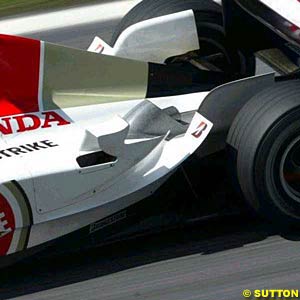 First qualifying session saw the BAR teammates' rivalry continue, Jacques Villeneuve making an error on an otherwise faster lap onto he last straight through turns13 and 14, dropping his top speed along the straight. Jenson Button's lap was tidier and he clocked an extra 2km/h on the straight and beat Villeneuve by two tenths.
First qualifying session saw the BAR teammates' rivalry continue, Jacques Villeneuve making an error on an otherwise faster lap onto he last straight through turns13 and 14, dropping his top speed along the straight. Jenson Button's lap was tidier and he clocked an extra 2km/h on the straight and beat Villeneuve by two tenths.
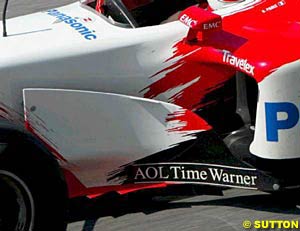 Toyota aerodynamics development is accelerating with the new tunnel at the factory in Germany. The new bargeboards were seen with Ferrari-like teeth along the lower edge and a McLaren-style Gurney along the top edge. The cooling package still consisted of the flip-up outlets and chimneys around the exhaust pipes.
Toyota aerodynamics development is accelerating with the new tunnel at the factory in Germany. The new bargeboards were seen with Ferrari-like teeth along the lower edge and a McLaren-style Gurney along the top edge. The cooling package still consisted of the flip-up outlets and chimneys around the exhaust pipes.
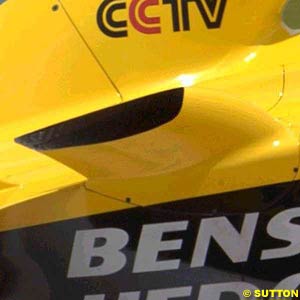 Jordan adopted larger chimney for the heat, the car's compound angle radiators (like Ferrari/Toyota) needing an unusual outlet placed on the outer face of the chimney for efficiency.
Jordan adopted larger chimney for the heat, the car's compound angle radiators (like Ferrari/Toyota) needing an unusual outlet placed on the outer face of the chimney for efficiency.
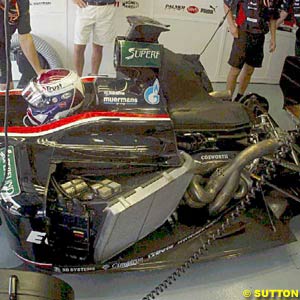 It now appears that Minardi's contract with Cosworth does not provide the latest spec engines; instead, the team have an older and less powerful specification. They also have older specification tyres from Bridgestone as a result of the late signing of the tyre deal. These shortcomings explain part of the team's lack of pace, when they were reasonably expected to demonstrate better pace in comparison to Jordan with parity in engine and tyres.
It now appears that Minardi's contract with Cosworth does not provide the latest spec engines; instead, the team have an older and less powerful specification. They also have older specification tyres from Bridgestone as a result of the late signing of the tyre deal. These shortcomings explain part of the team's lack of pace, when they were reasonably expected to demonstrate better pace in comparison to Jordan with parity in engine and tyres.
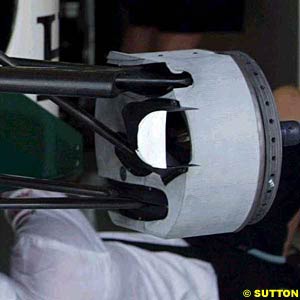 One novelty at Jaguar was the material the front brake ducts are made from: they now use a reflective heat resistant composite similar to BAR's exhaust covers.
One novelty at Jaguar was the material the front brake ducts are made from: they now use a reflective heat resistant composite similar to BAR's exhaust covers.
Please Contact Us for permission to republish this or any other material from Atlas F1.
|
Volume 9, Issue 13
Malaysian GP Review
2003 Malaysian GP Review
Technical Review: Malaysian GP
Articles
The Changing of the Guard
The Buck Stops Where?
Ann Bradshaw: View from the Paddock
Uncorked
Stats Center
Qualifying Differentials
SuperStats
Charts Center
Columns
Season Strokes
On the Road
Elsewhere in Racing
The Weekly Grapevine
> Homepage |